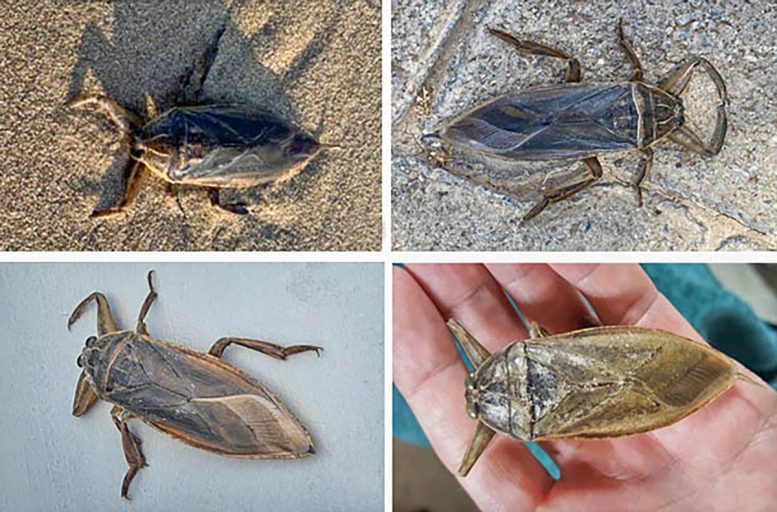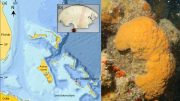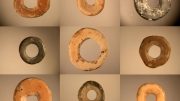
The giant water bug, a large and potentially painful predator, has been spotted for the first time in Cyprus, sparking interest and investigation by scientists. This finding underscores Cyprus’s rich biodiversity and highlights the importance of citizen science in monitoring environmental changes and species migrations. Credit: Hadjiconstantis et al.
Cyprus, known for its stunning, sun-kissed shores, stands as a Mediterranean biodiversity haven. Yet, it’s the island’s picturesque beaches, rather than its rich insect life, that usually capture attention. However, the keen eyes and curiosity of some beachgoers have provided important information about a species never recorded before on the island: the giant water bug, also known as a toe biter.
Scientists Michael Hadjiconstantis from the Association for the Protection of Natural Heritage and Biodiversity of Cyprus, Iakovos Tziortzis from the Ministry of Agriculture, Rural Development and Environment of Cyprus, and Kadir Bogaç Kunt from the Cyprus Wildlife Research Institute collected information and specimens from an increasing number of records of the giant water bug on the east coastline of the island in late spring and summer of 2020 and 2021.
The species, known for inhabiting ponds and slowly moving freshwaters, had never been recorded on the island before, although established populations are known in adjacent Mediterranean countries such as Greece, Turkey, and Israel.
The Giant Water Bug: A Formidable Predator
Also referred to as the Electric light bug, this giant water bug is described as a vicious hunter, praying on invertebrates, fish, turtles, and even birds. What is even scarier is that, as the largest European true bug and the largest European water insect, measuring up to 12 cm, it has a reputation for inflicting very painful bites when handled carelessly.
Its appearance, mainly on the eastern coastal front of the island, was initially recorded by swimmers, who were surprised by the fearsome looks and size of the bug. They either directly contacted the experts or published photos and videos online, mainly on Facebook groups related to biodiversity. The authors collected some of the specimens for further study.
They also proceeded with an extensive online search on relevant online observation platforms (i.e. iNaturalist) in order to track any other reports of the species on the island. In addition, they sampled nearby wetlands, but did not spot the bug. End to end, a total of seven sightings were eventually recorded: five from social media and two after direct communication with the author team.
Two specimens were obtained and examined morphologically to verify the species. The observations were recorded in a research article in the open-access journal Travaux du Muséum National d’Histoire Naturelle “Grigore Antipa”.
Having in mind that the toe biter is an iconic species accompanied by creepy stories concerning its encounters with humans, the authors assume that it is unlikely that it had gone unnoticed for too long. They consider it possible that several migration events might have been triggered in a short period of time by nearby countries hosting the species, such as Israel, Lebanon, and Syria. The specimens could have been transferred by wind or sea currents, as assumed by other researchers, or could have been driven by a decrease in food resources in their initial area of distribution.
Despite the number of recordings in a short timeframe, no conclusions can be drawn for the moment on the establishment of a population of the species on the island. This is further to be investigated, and as the initial recording of the species, citizen science can have an important role in this. The authors urge the public to be alert: “Naturalists looking for alien-like critters can provide valuable information on the presence and a possible establishment of the species through citizen science.” Until then, they warn: “Cypriots should keep their eyes open and their toes out of the water.”
Reference: “On the importance of citizen-science: first records of the Giant water bug Lethocerus patruelis (Hemiptera, Belostomatidae) in Cyprus” by Michael Hadjiconstantis, Iakovos Tziortzis and Kadir Bogaç Kunt, 31 December 2023, Travaux du Muséum National d’Histoire Naturelle “Grigore Antipa”.
DOI: 10.3897/travaux.66.e94457









Be the first to comment on "Alien Invasion or Natural Wonder? Scientists Discover Giant Water Bug on the Island of Cyprus"